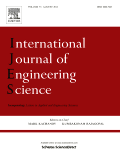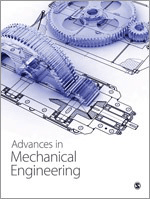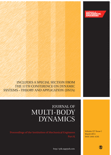
MECHANISM AND MACHINE THEORY
Scope & Guideline
Advancing the Frontiers of Mechanism and Machine Theory
Introduction
Aims and Scopes
- Mechanism Design and Analysis:
The journal covers the design, synthesis, and analysis of various types of mechanisms, including robotic arms, compliant mechanisms, and deployable structures. It emphasizes innovative approaches to mechanism optimization and performance enhancement. - Dynamic Modeling and Control:
Research in this area includes the dynamic modeling of mechanisms and machines, focusing on their behavior under various loads and conditions. Control methodologies for precise manipulation and tracking in robotic systems are also a key focus. - Kinematics and Dynamics:
Papers often explore kinematic analysis, workspace optimization, and dynamic performance evaluation of robotic systems and mechanisms, addressing challenges such as singularities and compliance. - Multibody Dynamics:
The journal features studies on multibody systems, including their dynamic interactions, stability, and control. This includes the application of advanced computational techniques for analyzing complex mechanical systems. - Innovative Manufacturing Techniques:
Research on the application of advanced manufacturing techniques, such as 3D printing and CNC machining, for the development of precision mechanisms and components is also a prominent area of focus. - Applications in Robotics and Automation:
The journal emphasizes the application of theoretical research to practical problems in robotics, including exoskeletons, rehabilitation robots, and automated machinery.
Trending and Emerging
- Soft Robotics:
Research on soft robotic mechanisms is gaining traction, focusing on pliable materials and designs that mimic biological systems, enhancing adaptability and safety in human-robot interactions. - Artificial Intelligence in Control Systems:
The integration of AI and machine learning techniques for control systems in robotic mechanisms is a growing area, allowing for adaptive and intelligent responses in dynamic environments. - Compliant Mechanisms:
There is an increased focus on compliant mechanisms that achieve motion through elastic deformation, which offers advantages in design simplicity and functionality. - Sustainable and Eco-friendly Designs:
Emerging research emphasizes sustainable design principles and eco-friendly materials, examining how mechanisms can minimize environmental impact while maintaining efficiency. - Advanced Manufacturing Techniques:
The rise of additive manufacturing and digital fabrication methods is reflected in the journal, with studies exploring their applications in creating complex mechanisms that were previously difficult to manufacture. - Robotic Rehabilitation Systems:
A significant trend is the development of robotic systems designed for rehabilitation, focusing on assistive technologies that enhance recovery and mobility for individuals with disabilities.
Declining or Waning
- Classical Mechanism Theory:
While foundational theories and principles remain important, there has been a noticeable decline in papers solely focused on traditional mechanisms without incorporating modern computational techniques or innovative applications. - Static Analysis of Mechanisms:
Research centered on static analysis without considering dynamic interactions or real-world applications has decreased, as the field moves towards more integrated approaches that consider both static and dynamic behaviors. - Low-tech Applications:
There appears to be a waning interest in mechanisms designed for low-tech applications, with a shift towards high-tech, automated, and robotic systems that utilize advanced materials and control strategies.
Similar Journals

Machines
Innovating the future of technology through open research.Machines is a leading journal in the fields of engineering and computer science, published by MDPI in Switzerland since 2013. As an Open Access publication, it ensures that researchers, professionals, and students can freely access high-quality peer-reviewed research. The journal covers a diverse range of topics, including control and optimization, mechanical engineering, electrical engineering, and industrial manufacturing, boasting impressive rankings in various Scopus categories, such as Q2 in Computer Science and Control Systems Engineering. With a commitment to advancing knowledge and innovation in these critical areas, Machines serves as an essential platform for disseminating research findings and fostering collaboration within the academic community. By contributing to the ongoing dialogue in these dynamic fields, the journal plays a pivotal role in shaping the future of technology and engineering practices.

INTERNATIONAL JOURNAL OF ENGINEERING SCIENCE
Exploring Cutting-Edge Research for Tomorrow's EngineersInternational Journal of Engineering Science, published by Pergamon-Elsevier Science Ltd in the United Kingdom, stands as a premier platform for pioneering research in the diverse fields of engineering and materials science. Since its inception in 1963, this journal has consistently demonstrated its commitment to advancing academic discourse, maintaining an impressive trajectory that positions it in the Q1 category across multiple engineering disciplines including Mechanical Engineering and Mechanics of Materials as of 2023. With notable Scopus rankings—placing it in the top 5% percentile for Mechanical Engineering and related fields—this journal attracts high-quality, impactful research designed for both industry practitioners and academic scholars. Although it does not currently offer Open Access options, its readership is enriched by comprehensive peer-reviewed articles, fostering a deeper understanding of complex engineering problems and innovative solutions. The International Journal of Engineering Science continues to be an invaluable resource for researchers, professionals, and students committed to pushing the boundaries of knowledge in engineering and materials science.

MECHANICS RESEARCH COMMUNICATIONS
Catalyzing Progress in Mechanics and MaterialsMECHANICS RESEARCH COMMUNICATIONS, published by PERGAMON-ELSEVIER SCIENCE LTD, is a prestigious journal in the fields of Civil and Structural Engineering, Condensed Matter Physics, Materials Science, and Mechanical Engineering. With an ISSN of 0093-6413 and E-ISSN of 1873-3972, it has made significant contributions to the understanding and advancement of mechanics and materials since its inception in 1974. The journal is well-regarded in academia, holding a Q2 ranking across multiple categories as of 2023, and ranking in the 65th percentile for Mechanical Engineering. Researchers and professionals benefit from its peer-reviewed content, which includes a wide range of articles from fundamental research to applied technological developments. Although currently not an open access journal, it remains a vital resource for those focused on innovating within the engineering and materials science domains. With its established legacy, MECHANICS RESEARCH COMMUNICATIONS continues to shape the discourse in mechanics and engineering, making it essential reading for students and practitioners alike.

International Journal of Mechanical System Dynamics
Shaping the Future of Control Systems and DynamicsInternational Journal of Mechanical System Dynamics, published by WILEY, is a premier open-access journal dedicated to advancing the field of mechanical engineering and control systems. Launched in 2021, this journal has rapidly established itself as a vital resource for researchers, professionals, and students by providing a platform for high-quality research and innovative methodologies in mechanical systems and dynamics. With an impact factor that reflects its significant contributions to the field, the journal is positioned in the Q2 quartiles of both the Control and Systems Engineering and Mechanical Engineering categories. Accessible online, it offers a transparent publication process and engages a global audience, making it a crucial venue for disseminating cutting-edge research findings. As of 2023, the journal boasts notable Scopus rankings, including 292nd in Mechanical Engineering and 148th in Control and Systems Engineering, positioning it favorably among its peers. With plans for continued growth through 2024, the International Journal of Mechanical System Dynamics stands at the forefront of mechanical innovation and interdisciplinary collaboration.

Advances in Mechanical Engineering
Connecting Scholars to Shape Engineering ProgressAdvances in Mechanical Engineering is a premier open-access journal published by SAGE Publications Ltd, dedicated to the advancement of theoretical and applied research in the field of mechanical engineering. With an ISSN of 1687-8132 and an E-ISSN of 1687-8140, this journal has been a vital resource for scholars and practitioners since its inception in 2009. Housed in the United States, it operates under a commitment to ensure free and immediate access to its high-quality content, enhancing collaboration and innovation across the global engineering community. With a noteworthy Q2 ranking in the mechanical engineering category and a solid Scopus rank placing it in the 59th percentile, the journal serves as an influential platform for cutting-edge research, theoretical advancements, and comprehensive reviews. As the field evolves, Advances in Mechanical Engineering continues to cater to the rigorous needs of researchers, professionals, and students, striving to transform knowledge into tangible engineering solutions. This journal's commitment to excellence makes it a significant contributor to the mechanical engineering field, encouraging dynamic discussions and implications for the future.

PROCEEDINGS OF THE INSTITUTION OF MECHANICAL ENGINEERS PART K-JOURNAL OF MULTI-BODY DYNAMICS
Bridging Theory and Practice in Dynamics ResearchPROCEEDINGS OF THE INSTITUTION OF MECHANICAL ENGINEERS PART K-JOURNAL OF MULTI-BODY DYNAMICS, published by SAGE PUBLICATIONS LTD, stands as a pivotal platform for research dissemination in the fields of Mechanical Engineering and Condensed Matter Physics. With an ISSN of 1464-4193 and an E-ISSN of 2041-3068, this journal covers a broad spectrum of topics related to multi-body dynamics, aiming to facilitate the exchange of knowledge among researchers, professionals, and students alike. With its impressive ranking in the Q2 category for both Mechanical Engineering and Condensed Matter Physics, the journal is recognized for its quality and relevance, placing it within the top 64th and 58th percentiles of its respective fields according to Scopus rankings. Housed in the United Kingdom and accessible via various academic platforms, this journal operates without an open access policy, ensuring rigor in the peer-review process. By bridging theoretical understanding and practical applications, the journal continues to contribute significantly to advancements in multi-body dynamics, making it an essential resource for those engaged in cutting-edge engineering research.

STROJNISKI VESTNIK-JOURNAL OF MECHANICAL ENGINEERING
Bridging Theory and Practice in Mechanical EngineeringSTROJNISKI VESTNIK-JOURNAL OF MECHANICAL ENGINEERING is a prestigious publication that has been disseminating cutting-edge research in the field of mechanical engineering since 1974. Published by the Association of Mechanical Engineers Technicians Slovenia, this journal serves as a critical platform for professionals, researchers, and students aiming to explore advancements in mechanical engineering and mechanics of materials. With a category ranking in the Q3 quartile for both Mechanical Engineering and Mechanics of Materials, the journal reflects a robust engagement with contemporary research and practices, contributing to the ongoing discourse within these vital disciplines. Although currently not open access, the journal is committed to providing high-quality, peer-reviewed articles that facilitate knowledge sharing and innovation. It is indexed in Scopus, maintaining respectable standings within its categories, thereby underlining its importance and impact in the global academic community.

Opir Materialiv i Teoria Sporud-Strength of Materials and Theory of Structures
Fostering Rigorous Research in Material and Structural IntegrityOpir Materialiv i Teoria Sporud - Strength of Materials and Theory of Structures is a prestigious open-access journal published by BUDIVELNIK, focusing on significant developments in the fields of material science and structural engineering. Established in 2009, this journal facilitates the dissemination of original research articles, theoretical analyses, and case studies related to the strength of materials and structural stability. The journal aims to bridge the knowledge gap between academia and industry, fostering innovation and practical applications in construction and material technology. With its commitment to open access, Opir Materialiv i Teoria Sporud ensures that vital research is accessible to a global audience of researchers, professionals, and students, thereby contributing to the advancement of engineering practices and safety standards. The journal is based in Kyiv, Ukraine, and encourages rigorous academic discourse within its scope, making it an essential resource for those engaged in structural engineering and material sciences.

Frontiers in Mechanical Engineering-Switzerland
Pioneering Research for a Sustainable FutureFrontiers in Mechanical Engineering-Switzerland, published by FRONTIERS MEDIA SA, is a pioneering open-access journal that has been fostering innovations in the field of mechanical engineering since its inception in 2015. Based in Switzerland, this journal provides a robust platform for disseminating cutting-edge research across multiple disciplines within mechanical engineering, including materials science, industrial and manufacturing engineering, and computer science applications. With impressive Scopus rankings, including Q2 statuses in key categories such as Industrial and Manufacturing Engineering and Mechanical Engineering, it stands out as a valuable resource for researchers and practitioners aiming to stay abreast of trends and breakthroughs in these fields. By embracing open-access principles, the journal ensures that high-quality research is readily available to a global audience, thereby promoting collaboration and knowledge sharing. As it continues to grow, Frontiers in Mechanical Engineering is poised to make significant contributions to both academic and professional communities, enhancing understanding and advancing practices in engineering disciplines.

Transactions of the Korean Society of Mechanical Engineers A
Advancing Mechanical Engineering Innovation.Transactions of the Korean Society of Mechanical Engineers A is a leading academic journal dedicated to the field of mechanical engineering, published by the Korean Society of Mechanical Engineers. With an ISSN of 1226-4873 and an E-ISSN of 2288-5226, this journal serves as a vital platform for disseminating innovative research and advancements in mechanical engineering. Situated in South Korea, the journal aims to foster knowledge exchange among researchers and professionals by publishing high-quality, peer-reviewed articles that cover a broad range of topics, including but not limited to manufacturing processes, thermodynamics, and materials science. Although it currently holds a Q4 ranking in the Mechanical Engineering category and is positioned in the 12th percentile of Scopus rankings, the journal is dedicated to expanding its impact and visibility in the global academic community. As it converges from 2007 to 2024, Transactions of the Korean Society of Mechanical Engineers A represents an essential resource for those seeking to advance their understanding and research within this dynamic discipline.